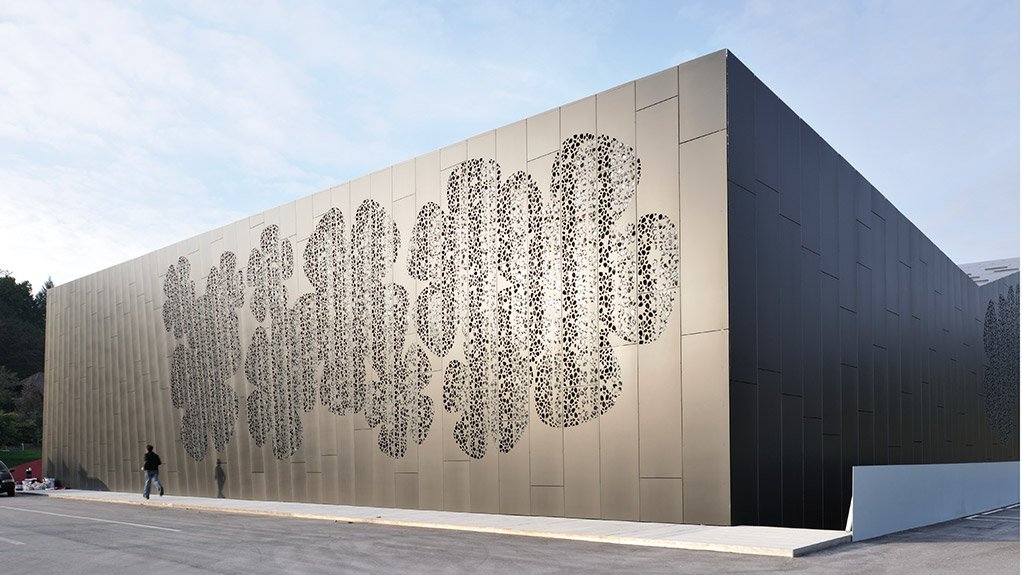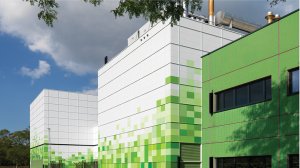Aluminium composite cladding/material (ACP or ACM) is widely used on building facades internationally, and although very much in its infancy in South Africa, it is slowly gaining traction. It is preferred over painted surfaces owing to its colour retention, corrosion resistance and low maintenance properties says Johannesburg-based metal supplier Consolidated Steel Industries aluminium subsidiary Stalcor MD Craig du Plessis.
ACP consist of three layers – namely two outer layers of aluminium skin that sandwich a polyethylene or mineral core material, that forms the middle layer. The aluminium skin is coil coated with various paint finishes in a large array of colour options, but a polyvinylidene difluoride coating is most common for colour retention.
ACP can be used for a variety of applications. “The uses for ACP are vast. It can be used internally or externally for signage, cladding or as a feature wall with the use of bespoke perforated designs, to name just a few,” explains Stalcor aluminium composite specifier Candice Laubscher. “Or for shopfronts, balustrades, elevators, and splashbacks,” adds Stalcor aluminium composite product manager Robin Hide.
In addition, there are two main markets for these products – cladding (facades) and signage. The ACP used in cladding and signage are very similar, they are manufactured to different specifications, Hide points out. For example, signage panels can be thinner, while facade panels should be thicker with a longer guarantee.
There are also various benefits to using ACP. “ACP can last many years without needing to be repainted. There is also no need to wait between coats or layers to dry, so the panels can be installed almost overnight,” he adds.
Further, the panels allow for greater design opportunities, states Laubscher. She notes that designers can add an almost three-dimensional look to facades as the panels can be bent and curved, or add perforated designs that will be visible during the day and at night with the use of back-lighting.
Architects can change panels easily to keep up with the latest design trends, Laubscher reiterates, or when new improvements have been made to the design of the panels, adds Du Plessis. The colours of the panels can also be colour matched to specific corporate colours. This is part of the versatility of ACP products for facade designs.
“You can give new life to old buildings,” maintains Du Plessis. The panels allow for designs that many traditional cladding options do not provide. “The panels are also guaranteed against delamination and fading,” stresses Hide.
In January, Stalcor became the exclusive distributor of Alubond aluminium composite panels. Alubond produces fire-rated cores in Euroclass B and FR-A2, as well as non-fire-rated cores such as low-density polyethylene. Alubond FR-A2 can allow for a three-hour fire rating, when combined with a certified substrate system. This is an important consideration when choosing a panel for cladding, as the possibility of a fire in a building is an important consideration.
Last year, Alubond, comprising 94% inorganic mineral core materials, passed the ASTM e119 tests, which test the fire rating of building and construction materials. This means the cladding system passed the three-hour fire rating test successfully and is the first and the only brand in the United Arab Emirates to have achieved this.
The aim with the addition of Alubond is to diversify the range of products that Stalcor – whose main competency is as a merchant and stockist of aluminium – can offer the market, says Du Plessis. Subsequently, Stalcor can now provide ACM products for the building market.
Edited by: Zandile Mavuso
Creamer Media Senior Deputy Editor: Features
EMAIL THIS ARTICLE SAVE THIS ARTICLE
ARTICLE ENQUIRY
To subscribe email subscriptions@creamermedia.co.za or click here
To advertise email advertising@creamermedia.co.za or click here















